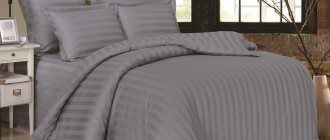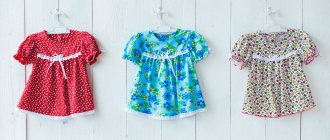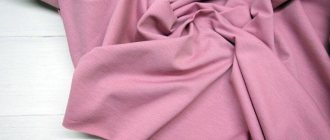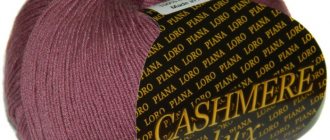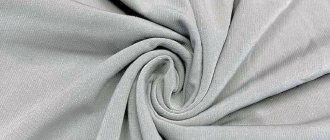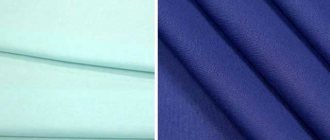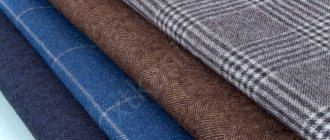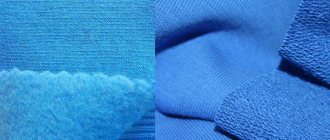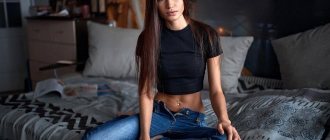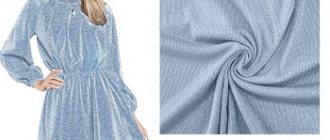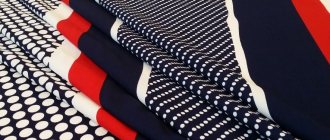What kind of kulirka fabric (kulirka satin stitch) is a smooth and thin knitted fabric, produced from pure cotton; interestingly, it does not stretch in length and stretches well in width. Used for children's things, bed linen, home clothes. This is a brief summary of what you need to know; read more about this natural material below.
Photos close up:
What is a cooler
Translated from French, “kulirka” means “bend.” Knit fabric is a type of single-layer cross-knitted fabric. The main element of the structure is a loop consisting of a connecting broach and a frame. On the front side, the cooler fabric looks like vertical braids. The back loop design is reminiscent of brickwork. Cooler fabric is the smoothest and thinnest knitwear, which can be made from 100% cotton or with the addition of 5-10% lycra to increase the shape and wear resistance of the fiber.
The canvas is available in different densities. The thinnest surface is created from 100% cotton with a small addition of elastane. This fabric is used to make linen. High-density kulirka material is used for sewing knitted outerwear. Due to the high content of chemical fibers in dense fabric, products do not stretch, shrink, or wrinkle.
Cooking surface - what is it like?
Not all knitwear is the same - knitwear from different manufacturers can have different properties. Why is this happening? The fact is that knitted fabric is knitted on special machines from threads spun from natural cotton. Depending on the country of origin and the quality of the raw material, cotton fibers can have a length ranging from 20 to 70 mm. This indicator directly affects the final quality of the canvas.
What quality of cotton is suitable for making kulirka?
Peñe is a type of cotton knitwear with the best consumer properties. Peñe cotton threads are made from fibers 30-70 mm, they are characterized by maximum strength and uniformity of structure. They have no villi, pores, or vellus fibers. In addition to decent quality, peñe quality threads also undergo special processing to eliminate residual defects. As a result, things made from knitted fabric do not roll up or lose their shape.
Peñe Premium (Peñe Compact) - what does this mean? This is the name given to the most silky, smooth, wear-resistant type of knitted fabric. It almost doesn't wrinkle, doesn't roll, doesn't shrink. The highest quality cotton is used for it.
Ring/carde is perhaps the most popular type of cotton knitwear, made from looser threads based on medium-length cotton fibers (25-35 mm). It has become so widespread due to its affordable cost and acceptable characteristics. The quality of the weave fabric based on ring cotton is not bad; it can be visually “read” by the presence of a short “fuzz” on the surface of the material.
O/ E ( Open End) - inexpensive knitwear made from cotton fibers of minimal length (20-30 mm). The strength of such fabric is low, but all the other traditional advantages of cotton - hygroscopicity, ability to pass air, hypoallergenicity - remain in place. O/E jersey may stretch after several washes. Some manufacturers use additional processing of fibers with enzymes - then the surface of the material becomes resistant to pilling.
Thanks to the use of knitted weave, the 100% cotton weave is a stretchable fabric.
At the same time, combinations of natural cotton fiber with lycra (elastane) are not uncommon. Such fabrics are called mixed fabrics - they use a mixture of different fibers in different ratios (most often - 95% cotton and 5% elastane). The maximum permissible limit for adding elastane is 10% - this cooler is called a “full-lycra cooler.”
The density of 100% cotton stockinette can vary from 120 to 380 g/m2, and material with an elastane additive has characteristics from 160 to 340 g/m2.
What is the advantage of stockinette with the addition of elastane? It stretches better and retains its original shape longer than its counterpart made from natural cotton.
Description
When buying knitwear, the question often arises: what kind of fabric is it? Everyone is familiar with the traditional names (calico, cotton, flax). However, when many buyers see the name of the cooler on the label, they are perplexed. Fabric made by machine using stockinette knitting cotton threads produces excellent quality children's, women's and men's clothing. Kulirka knitwear is thin and smooth, so shirts, shorts, T-shirts, and robes made from it are highly valued by connoisseurs.
Knitted
Knitted fabric is a type of weaving, there are only 3 of them:
- “Open end” (o/e) - short yarn is used here - up to 27 mm. She wrinkles a lot. Used in sewing linen. Price from 139 rubles.
- “Penya” is the highest quality canvas. They use long fibers - up to 79 cm. What kind of fabric is kulirka-pene: high-quality material that does not form pills, is elastic, and does not shrink. The price for such quality is from 220 rubles.
- “Carde” - when they see such a postscript, they immediately ask the question “what kind of fabric is this?” This is a medium length yarn - up to 35 mm. Cost - from 165 rubles per 1 meter. “Colored melange” refers to a combination of colors.
Compound
As already mentioned, the cooler mainly contains pure cotton fibers, but sometimes additional materials are added to it for elasticity:
- Polyurethane. Increases durability and elasticity. Polyurethane has hypoallergenic characteristics and ensures the preservation of the color of the fabric. Even after many washes, a product with this composition will remain bright. The disadvantage of this connection is the fact that after the first wetness the clothes shrink slightly.
- Polyester. Often added together with polyurethane. Thanks to this, clothes do not fade or shrink after washing. Polyester provides cotton fiber with high density. The disadvantage is that the material is hard and hygroscopic.
- Lycra. The additive is used to make clothes stretch better across the width. A cooler with lycra is also called singing.
- Wool, silk. Materials are also sometimes added to the stockinette. Such a connection is rarely made.
Manufacturing
Cooling is done industrially using special equipment. The appearance of the fabric is very similar to the technique of stockinette stitch in hand knitting. Typically, only one cotton fiber is used in the production process. However, the cooler often includes components such as:
- polyurethane;
- polyester;
- lycra;
- wool;
- silk.
According to the manufacturing technique, knitted satin stitch is included in the class of cross-knitted knitwear, since the manufacturing process is carried out in a direction transverse to the fabric.
They produce single and double fabric, for the production of which machines with one and two needle beds are used, respectively . However, such fabric quite simply unravels in the horizontal direction, and in case of mechanical rupture, it unravels vertically. Lycra is used to make the fabric as flexible as possible.
Properties
Since the drawstring fabric is double-sided, durability is its main quality. The characteristics of the fabric include good breathability, which allows the body to ventilate and breathe. This property is suitable for making clothes from cotton wool for any season. Waist stitch is especially suitable for babies - in diapers made from such weaving, a child will never develop diaper rash. Knitwear can be colored or plain. Thanks to the unique structure of the weave fabric, the designs on it last for a very long time. Main properties of the canvas:
- strength;
- hygroscopicity;
- wear resistance;
- hygiene.
Does it stretch or not?
Judging by customer reviews, the cuff fabric stretches greatly in width, but hardly stretches in length. This characteristic provides an excellent opportunity to not restrict movement when wearing underwear, a T-shirt or other clothing that fits close to the body. This property also prevents the products from stretching after washing and retaining their shape for a long time, which indicates a long service life.
Reviews about the material
People's opinions about this fabric are very positive. It is very easy to use and many girls buy it to sew some things for themselves. Here are some of the reviews:
- A wonderful material for children's things, it retains heat well. It has no harmful effect on the baby’s skin, is delicate, and absorbs water perfectly. In the family, we mainly buy things from knitwear for our daughter; there are a lot of T-shirts, sundresses and underwear. (Maria)
- This is definitely the best option for sewing not only children's clothes, but also for adults. Pay attention to the composition before purchasing, it must contain real cotton. This thing will last a long time. (Anastasia)
- For my elderly grandmother, I always buy things from this fabric, she herself asks for it. Convenient and comfortable to walk on, does not cause redness, such as from chintz. Quite a reasonable price and durability, cannot but rejoice. (Irina)
- For my second child, I buy things only from this fabric. My eldest son is 8 years old and wears it perfectly. Has no problems, although he is allergic to certain types of materials. And I myself am very pleased, since it is easy to care for, any stains are easily washed off, and, as they say, it is indestructible. (Oksana)
Shades of pink
In conclusion, it is worth noting that this fabric is very popular among parents. It has gained popularity due to its simplicity, low price and long service life. Very often used for sewing various dresses, trousers, underwear and bedding. Also very often, instead of lining fabric, interlock is used.
It is more dense and resistant to mechanical damage. Waistcoat fabric also has a number of disadvantages and can be damaged due to improper care and handling. But be that as it may, this material is at the peak of its popularity, and it is unlikely that insignificant disadvantages will force one to abandon its use.
Production
The manufacturing process of the cooler fabric is controlled at all stages of production. The fabric is made from interwoven knitted threads (cotton plus additional materials). The cooler is made from three types of yarn, depending on the scope of application:
- Peña. Consists of long fibers (80 cm). The most expensive and high-quality raw materials, since the length helps the material keep its shape well.
- Card. The yarn length is medium (27-35 cm). This fabric is less elastic and durable.
- Open end. The shortest yarn (less than 27 cm). It includes residues from previous types of fibers. Used in the field of sewing products that do not require an ideal shape.
Invention of fabric and production method
The history of the origin of the culinary material began back in 1589. An English priest decided to help his bride, who made a living by knitting stockings. To do this, I made a device: I attached rows of curved needles to a horizontal beam, thanks to which the yarn bent (or curled), forming loops. The manual device was subsequently improved and became known as a flat knitting machine. This contributed to the massive spread of knitwear production throughout Europe.
Modern kulirka is made by cross-knitting in one layer. Its essence is the sequential formation of loops from one thread and connection with the previous row. Thanks to periodically repeated bending, the loops come out identical in shape and size.
The kulirka is woven using stocking knitting: the columns of loops are clearly visible on the front side, and on the back there is a wave-like pattern reminiscent of brickwork.
The finished fabric has a low pile on the reverse side, which is removed by special sanding. Knitwear acquires a flat, smooth surface with a slight shine, and also becomes resistant to tightening and damage from sharp objects.
Important! The main difference from other knitted materials is thickness. Kulirka is the thinnest type of knitwear, therefore it is used for underwear and children's clothes. Interlock and footer are denser fabrics, often brushed. Used for sewing warm autumn-winter clothes.
Varieties
Cotton fabrics have proven themselves to be a material that can be easily dyed. The stockinette stitch is no exception, and the unique weaving helps create a special decorative effect. Dyeing of the canvas occurs using the traditional method, no different from other methods of adding color to fabrics. There are three types of lining fabric:
- Melange knitted surface. In its production, cotton threads of different colors are used, which are always combined with each other.
- Smoothly dyed fabric. The material is painted evenly, but can be of different colors.
- Knitted stitch with a printed pattern. The fabric is characterized by high surface density. The printed pattern is applied using different technologies.
Advantages and disadvantages
For those with sensitive skin and those who appreciate comfort, the cooler is the ideal fabric. The material has many advantages - it absorbs moisture and allows air to pass through, it is practical and hypoallergenic, strong and durable. Clothes made from stockinette do not require special care, are light, airy and are sold at an affordable price. The variety of colors, styles and the ability to be used in many areas of life are also a big plus for this fabric material. Waist linen has only one drawback: after incorrect washing, the item may shrink in size.
Scope of application
After it has become clear what it is - kulirka fabric, you need to figure out what kind of clothes are made from it. The versatility of the material allows you to sew from it:
- Underwear for adults. It is known that elevated temperature leads to poor health. In some cases it can lead to infertility. Therefore, the underwear should allow air and moisture to pass through.
- T-shirts and tank tops. Produced for both children and adults. In summer, active sweating can lead to sweating, severe skin irritation and even allergies. It is necessary for the moisture to escape and in this case the cooler is better suited than other fabrics.
- Dresses. Regular casual dresses are often made from cotton fabrics. They allow you to maintain air and temperature exchange even on a very hot hike.
- Robes. Bathrobes and dressing gowns made from kulirka are very popular, because the fabric is soft, does not stick to the body and creates the comfort that you should have after a hard day. In addition, they do not lose color for a long time, even with constant wear.
- Nighties. Many note that they are more comfortable than silk models. The reason for this is softness and lightness. Plus, they are much cheaper.
- Hats. Summer baseball caps help your head not to sweat and allow you to play sports longer, including outdoor games.
- Sportswear. Active sports (running, cycling, cardio exercises in the gym) should be carried out in light, breathable underwear.
You can see photos of clothes from the cooler below.
Comparison with analogues
There are many types of knitted fabric, but each one is different. The characteristics of each canvas are such that they are not interchangeable. Brief characteristics of fabrics similar to kulirka:
- Footer. A warm, dense fabric that is smooth on the front side and softly brushed on the back. Knitwear stretches slightly, shrinks noticeably when soaked, and does not form pills. Products made from lining can only be washed at low temperatures up to 30°C. The canvas is recommended for creating warm clothes.
- Ribana. Double-sided knitwear, which is obtained by double cross-knit weaving. The surface of the ribana is structured on both sides in the form of small stripes. The material holds its shape well and only stretches in width. Ribana is usually used to create children's collections.
- Pique. Lightweight mixed-weave knitwear with anti-shrink properties. Products can be safely washed in hot water. Pique is great for creating summer clothes.
- Pizza dough: recipes
- How to quickly raise blood pressure at home
- Spondyloarthrosis of the lumbosacral spine: treatment
Kulirka and interlock - what's the difference?
Interlock is a widely used knitwear. The fabric is obtained by weaving “elastic”, when the back and front columns alternate. Interlock is a double-sided material, which provides it with low elongation in length/width and high density. If the thread accidentally breaks, this knitted fabric almost does not unravel. The fabric is used to make children's clothing, but due to the density of the weave, it is not suitable for a summer collection. Interlock is superior to cooler in strength and wear resistance, but the latter is lightweight and thin.
How does cooler differ from footer and interlock?
For kids and adults, everyday clothes are sewn from footer. This is a strong, comfortable, dense, pleasant, cotton thing. Cotton is used to make such a very soft textile with a smooth outer surface. There is also a small fleece inside. Well resistant to the appearance of pellets or arrows.
Double elastic is the name given to thin interlock. Today, manufacturers often add synthetic yarns to the material. Although ideally, only natural fibers should be used. In case of mechanical damage, unlike the cooler, puffs do not appear. In the photo you can see the difference in fabrics.
Children `s dress
Interlock will always be double-sided. Natural yarns are inserted into this material using a special method. Even if the material is of poor quality, it will not lose its shape after long-term use.
You might be interested in Description of ribbed fabric, composition and tensile characteristics
What do they sew from a cooler?
We figured it out a little, kulirka - what kind of fabric is it, but what is it used to sew? Satin stitch is a universal material. It is widely used for sewing both adult and children's clothing. Thanks to its hypoallergenicity and durability, the weave fabric produces very high-quality underwear, which is appreciated by people with sensitive skin. Clothes made from this knitwear for home use (pajamas, dressing gowns) are of high quality, comfortable to wear and affordable.
Summer clothes made from knitted satin stitch perfectly allow air to pass through, look great in both a tight-fitting and loose fit, and are light in texture. On hot summer days, skirts, trousers, tunics, leggings and other items made from this knitted fabric are ideal. Since the fabric absorbs liquid well, it is excellent for sewing high-quality sportswear. Most of the items produced from knitwear are for the youngest consumers:
- hats;
- slips;
- sliders;
- bodysuit;
- baby vests;
- diapers, etc.
How and where the material is used
Many women who have recently become mothers or have small children are well aware of what cooler material is and its areas of application.
The thing is that they use it every day when they take care of their babies. Knitwear made from this fabric is a leader in the production of practical and inexpensive children's clothing. A child's delicate skin is sensitive and susceptible to irritation. Especially during the summer months, when children spend a lot of time outside, running and playing. Therefore, the choice of clothing is especially important for them.
Plain-weave cotton baby clothes are usually too thick and heavy for the heat. Cooler knitwear, while highly durable and soft, is also very thin and unusually light. Therefore, children's items made from it have always been and will be in demand.
For the little ones they sew from fabric:
- baby vests;
- sliders;
- overalls;
- panties;
- tights;
- caps;
- booties.
For older children, the following is produced from the kulirka:
- T-shirts;
- T-shirts;
- blouses;
- dress;
- trousers;
- shorts;
- children's sets.
But not only children have access to things made from cooler fabric.
It is quite versatile and practical; adults’ wardrobes can also contain items made from this knitwear. For women this could be:
- open dresses;
- sundresses;
- blouses;
- robes;
- skirts;
- tunics;
- pajamas.
The clothes are suitable for women of different sizes; they fit perfectly on the figure, regardless of the loose or tight cut.
For men, they sew the following clothes from kulirka:
- shirts;
- T-shirts;
- shorts;
- shirts;
- trousers.
Basic rules of care
In order for items made from cotton fabric to last a long time, you need to know the rules for caring for them. Before first use, a new product must be washed. For this purpose, it is advisable to purchase a detergent for delicate washing: powder with a gentle composition or gel. Bleach, stain removers and other aggressive household chemicals can harm the material. Wash by hand or use delicate cycle in a washing machine. Before carrying out it, you need to take note of the following rules:
- the water temperature should not be higher than 30 degrees;
- It is better to spin manually using a towel (at least at the lowest speed);
- If there are stubborn stains, they must be removed with laundry soap or using a delicate stain remover.
It is better to dry things not vertically with clothespins, but horizontally on a towel. This is necessary to maintain the shape of the clothing. It is important to avoid exposure to sunlight so that the color of the product remains unchanged longer. Since knitwear does not wrinkle, it is not necessary to iron it. If ironing is required (for example, baby diapers), then the correct temperature is 110 degrees. As you can see, the cooler is an unpretentious material. With proper care, items made from this fabric will delight their owners for many years.
Caring for suede fabric
It is very easy to care for clothes made from this fabric, here are the basic recommendations:
- It is advisable to pour cold and soapy water for 2 hours before washing.
- If the stains are difficult, then laundry soap will do the job perfectly.
- You can also use stain removers.
- Can be washed by hand or at 40 degrees in a machine.
- Instead of regular powder, you can use liquid.
- When washing by hand, it is better to rinse in warm water, and the last time in cold water.
- When drying, it is advisable not to hang things out, but simply put them away from heating devices and direct sunlight.
- If you need to dry it as quickly as possible, you can put it in a terry towel for a couple of hours.
- After washing, you do not need to iron it, but preferably just shake it.
- If you had to use an iron, the temperature should not exceed 100 degrees.
Singing in various shades
Note! If you follow these tips, you can maintain the elasticity of things and their color for a long time.
Fabric price
The cost of the cooler is low. Finding and buying it today is not difficult. If this knitwear is not on sale in your city, then it is easy to order the material from a photo in the catalog and buy it in an online store. Fabric is often sold online at a discounted price, so such a purchase will be more profitable even taking into account delivery. Average cost of a cooler in stores in the Moscow region:
| Name | Price, ruble/meter |
| Cooler stretch | 680, 00 |
| Plain cooler | 370,00 |
| Kulirny stitch with lycra | 430, 00 |
Types of fibers - type of yarn
Kulirka is divided into several types according to the type of yarn. It can also be melange, smooth or printed with a pattern.
Peña
To create it, twisted yarn from long threads of cotton is used. Sanding is used during the manufacturing process to make the fabric smoother.
Children's summer dresses
The main advantages of foam are high strength, density, wear resistance, and beautiful appearance. Tunics and sweaters for the summer season are made from this yarn. Penya does not cause skin allergies.
There are also disadvantages. It is very difficult to process the edge of the fabric, due to the fact that it curls; if the composition contains lycra, then the item may shrink, arrows may form, and holes remain from being punctured by a needle.
The traditional version of penye is fabric made of 100% cotton; modern factories often add lycra and polyester to the composition to make the material more elastic.
You might be interested in: Characteristics and application of asbestos fabric
Carde
This type of fabric occupies an average position in various indicators, the yarn length is about 4 cm. Specifics: in terms of elasticity it is better than foam, average wear resistance and price.
Children's canvas "open end"
Carde yarn is quite thin and airy, air circulates well, and is soft to the body, which is why it is often used for children's clothes.
Pros: easy to care for, does not lose its shape, low cost, variety of appearance. You need to wash it carefully because there is a risk of shrinkage.
Carde is often used to create linen, bedding, and bathrobes because it does not cause allergies and is highly breathable.
Openend
To make the material, short yarn up to 3 cm is used. Main features: increased creasing compared to carde and pene.
Tight interlock
The main area of application is the manufacture of linen, so wrinkle resistance is not so important here. The fabric is inexpensive compared to the above.
Based on the above, we can conclude whether the cooler stretches or not. Elasticity is one of the main properties of this type of fabric; due to it, the shape of the clothing is maintained, and there is also a feeling of comfort.
